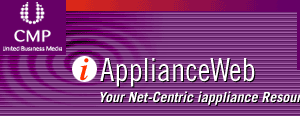|
Netcentric View:
Cerfboards, Noyceboxes, and Tier-0 Computing
By Bernard Cole
iApplianceWeb
(06/26/02, 12:10:52 PM GMT)
Since I started this column more than a year ago, I have been surprised by the issues and topics to which you respond. My hope was that we could generate some good dialog so I could get your help in getting a better focus on new technologies as they impact the way we do computing in a netcentric connected environment.
While I have some interesting and on-going discussions with some of you on these technical topics, the one subject that seems to strike a deep cord is the issue of naming this computing environment we are in. What that tells me is that many of you, like me, still struggle with the true nature of new computing and communications environment we are in and are trying to find the right terms to describe it.
In earlier columns I outlined why I use the term "Net-Centric" to describe the paradigm, and why the term "iappliance" is my choice of a generic term to describe the new kinds of devices and systems in that space.
Some companies, such as Wind River and Microsoft use terms such as "smart device computing," and others such as IBM, the term "pervasive computing." Even more frustrating to me is that many of you are using the term "embedded" to describe anything that is not a desktop. What it means is that when you talk to me, I must spend several minutes honing in on exactly what you are bringing to market or designing.
It can't be much of a definition if it is so broad that it takes minutes to describe what it is you are doing. In previous generations of computing, when the term "mainframe," or "minicomputer," or "desktop computer" and even "embedded computing" was used, the word described the essence of things. That is all I ask in defining a new computing environment.
Sethuraman (Panch) Panchanathan, Ph.D., Director of the Collaborative Research Program on Ubiquitous Computing (CUbiC) at Arizona State University suggested to me the term "ubiquitous computing." I have the same problem with that term as I do with smart devices and pervasive computing: they do not describe anything new. Computers and controllers have always been ubiquitous, pervasive, and smart; they are now just more so. Before the Internet was upon us, the number of 4-, 8-, -16, and 32-bit processors was in the several billions, more than the population of humans on earth. If that's not ubiquitous and pervasive I don't know what is.
What is new now is connectivity -- a specific type of connectivity evolving out of the TCP/IP network protocol that was a child of computing itself and is ubiquitous and pervasive across all types of computing. The main difference is ubiquitous connectivity of all computing devices and systems. There is nothing in the other terms I have come across that captures this essential feature.
As to the specific devices, some of you suggest the use of terms that are only applicable to a small segment such as information appliances or embedded Internet devices and applying them to all devices in this environment. Another term, Internet appliances, comes closer to a more generic term.
But whatever the term, it should capture the essence of what these devices do in the Internet-centric computing environment, just as the phrase "kitchen appliance" captures the essence of all devices in that environment, be it as large as a refrigerator or as small as an electric can opener "embedded" in a kitchen drawer.
Others of you have defined the systems you design in terms of the tools and building blocks used. Many cell phones and PDAs use real-time operating systems because of their extremely small memory footprint, and some times even real time and deterministic operation. But that does not make them embedded devices any more than putting a truck engine and wheels on a VW bus makes it a truck.
By that logic, the first desktop computers to emerge in the late 70s, years before the IBM PC, should have been called embedded computers because virtually everything was borrowed from earlier generations. My first desktop was built using the S-100 bus, which grew out of the embedded processor market of the 70s. That bus architecture was based on a passive backplane, not an active motherboard, in which all computing elements, from CPU to memory to peripherals plugged in and communicated over that bus. Sounds awfully like the embedded Compact PCI spec to me. My first "word processor" was one of those primitive text editors that embedded programmers used to enter code.
I don't think my compulsion about terminology is just some weird hang-up. From my experience in academia at Caltech and as a general science and technology writer in an earlier life, it seems to be common for such issues to arise at the beginnings of a new scientific or engineering paradigm. A great deal of time is spent defining not only the measurements that need to be made and the precise mathematical characteristics of each phenomenon, but on the language used.
It was not left up to marketing managers, PR and advertising agencies, or corporate "branding" departments to do. Their main aim is to protect corporate product turf and OEM channels rather than clear communications. In the electronics industry I fault the trade magazines and newspapers for which I have worked: rather than fulfill their role as arbiters of language and grammar they have left it to others, and the result is confusion.
Looking at the history of science and technology points to one way to solve this problem. For a new function or phenomenon, sometimes researchers usually give it a name totally unrelated to the problem domain. In quantum physics, some fundamental "particles" have been given the name "quarks" from one of the made up words that James Joyce used in one of his lyrical, if occasionally disturbing paeans to Ireland. That was my inspiration for the made up word "iappliance."
More prosaically, researchers use terms derived from the names of the investigators or pioneers in a field of endeavor, such as the terms Volt, Ampere, Ohm.
In this context, if my choices for names of the objects in this new environment is not acceptable, I have two suggestions, derived from two individuals whose activities made all of this possible, one, sadly, dead, but the other very much alive.
First, how about calling them "Noyceboxes," to honor the late Robert Noyce, who was pivotal in the development of the integrated circuit, the microprocessor and was a founder of Intel. Given that much of the new Internet and World Wide Web, as bandwidth gets higher, will be multimedia combinations of text, graphics, video and sound, it would be entirely appropriate.
My second candidate is "Cerfboard" or "Cerfing platform," to honor Vinton Cerf, who with Bob Kahn, was the architect of the ubiquitous TCP/IP protocol stack upon which all of this is based. We do "Cerf" the Web don't we?
Finally, for the more analytical among you, how about the term "Tier-0" computing devices? This term has a long history in computing, dating all the way back to mainframes in the '60s and '70s. The term derives from early mainframe/client/server designs, where Tier-3 machines are centralized mainframes and minis, Tier-2 are file servers, and Tier-1 are desktop systems, originally smart and dumb terminals and later desktop computers.
The name Tier-0 was originally used to describe any computing device smaller than a desktop and originally included mostly embedded computing and control devices. Now, of course, this category would include PDAs and practically any small footprint computing device, from set-top boxes, most consumer computing device, video game consoles and web-enabled cell phones. Of course, this naming hierarchy is not a perfect fit; first of all, net-centric computing is not hierarchical, but distributed and increasingly peer-to-peer. Nor does it cover the new types of computing architectures, such as network processors, which are oriented toward dataflow rather than control or data processing. Perhaps, Tier-X?
I didn't say the structure is perfect. But anything is better than the complete naming anarchy we have now.
What do you think? What is you candidate for the name for the generic computing device in this new environment?
Bernard Cole is site leader and editor of iApplianceweb and an independent high technology editorial services consultant. He welcomes your feedback. Call him at or send an email to .
For more information about topics, issues and technologies mentioned in this story go to the flashing icon in the upper left corner on this page or go to the iAppliance Web Views page and call up the associatively-linked Java/XML-based Web map of the iApplianceWeb site.
Enter the appropriate key word, product or company name to list instantly every news and product story, product review and product database entry relating to the topic since the beginning of the 2002.
|









![]()

